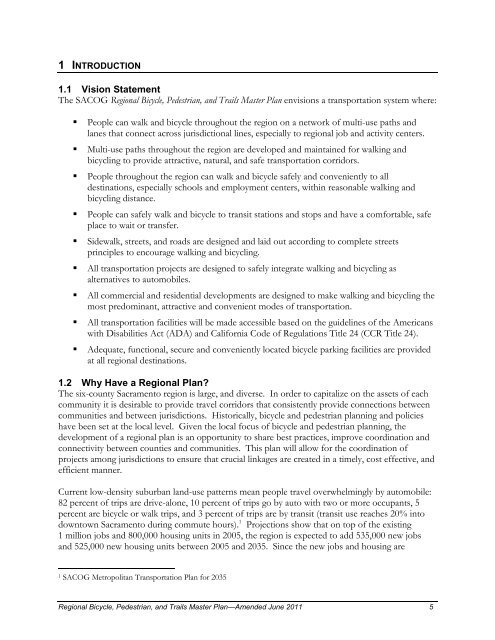Bicycle and Pedestrian Master Plan - sacog
Bicycle and Pedestrian Master Plan - sacog
Bicycle and Pedestrian Master Plan - sacog
Create successful ePaper yourself
Turn your PDF publications into a flip-book with our unique Google optimized e-Paper software.
1 INTRODUCTION<br />
1.1 Vision Statement<br />
The SACOG Regional <strong>Bicycle</strong>, <strong>Pedestrian</strong>, <strong>and</strong> Trails <strong>Master</strong> <strong>Plan</strong> envisions a transportation system where:<br />
• People can walk <strong>and</strong> bicycle throughout the region on a network of multi-use paths <strong>and</strong><br />
lanes that connect across jurisdictional lines, especially to regional job <strong>and</strong> activity centers.<br />
• Multi-use paths throughout the region are developed <strong>and</strong> maintained for walking <strong>and</strong><br />
bicycling to provide attractive, natural, <strong>and</strong> safe transportation corridors.<br />
• People throughout the region can walk <strong>and</strong> bicycle safely <strong>and</strong> conveniently to all<br />
destinations, especially schools <strong>and</strong> employment centers, within reasonable walking <strong>and</strong><br />
bicycling distance.<br />
• People can safely walk <strong>and</strong> bicycle to transit stations <strong>and</strong> stops <strong>and</strong> have a comfortable, safe<br />
place to wait or transfer.<br />
• Sidewalk, streets, <strong>and</strong> roads are designed <strong>and</strong> laid out according to complete streets<br />
principles to encourage walking <strong>and</strong> bicycling.<br />
• All transportation projects are designed to safely integrate walking <strong>and</strong> bicycling as<br />
alternatives to automobiles.<br />
• All commercial <strong>and</strong> residential developments are designed to make walking <strong>and</strong> bicycling the<br />
most predominant, attractive <strong>and</strong> convenient modes of transportation.<br />
• All transportation facilities will be made accessible based on the guidelines of the Americans<br />
with Disabilities Act (ADA) <strong>and</strong> California Code of Regulations Title 24 (CCR Title 24).<br />
• Adequate, functional, secure <strong>and</strong> conveniently located bicycle parking facilities are provided<br />
at all regional destinations.<br />
1.2 Why Have a Regional <strong>Plan</strong>?<br />
The six-county Sacramento region is large, <strong>and</strong> diverse. In order to capitalize on the assets of each<br />
community it is desirable to provide travel corridors that consistently provide connections between<br />
communities <strong>and</strong> between jurisdictions. Historically, bicycle <strong>and</strong> pedestrian planning <strong>and</strong> policies<br />
have been set at the local level. Given the local focus of bicycle <strong>and</strong> pedestrian planning, the<br />
development of a regional plan is an opportunity to share best practices, improve coordination <strong>and</strong><br />
connectivity between counties <strong>and</strong> communities. This plan will allow for the coordination of<br />
projects among jurisdictions to ensure that crucial linkages are created in a timely, cost effective, <strong>and</strong><br />
efficient manner.<br />
Current low-density suburban l<strong>and</strong>-use patterns mean people travel overwhelmingly by automobile:<br />
82 percent of trips are drive-alone, 10 percent of trips go by auto with two or more occupants, 5<br />
percent are bicycle or walk trips, <strong>and</strong> 3 percent of trips are by transit (transit use reaches 20% into<br />
downtown Sacramento during commute hours). 1 Projections show that on top of the existing<br />
1 million jobs <strong>and</strong> 800,000 housing units in 2005, the region is expected to add 535,000 new jobs<br />
<strong>and</strong> 525,000 new housing units between 2005 <strong>and</strong> 2035. Since the new jobs <strong>and</strong> housing are<br />
1 SACOG Metropolitan Transportation <strong>Plan</strong> for 2035<br />
Regional <strong>Bicycle</strong>, <strong>Pedestrian</strong>, <strong>and</strong> Trails <strong>Master</strong> <strong>Plan</strong>—Amended June 2011 5
















